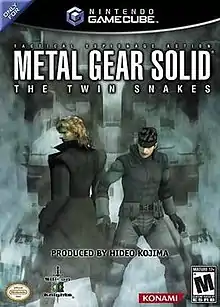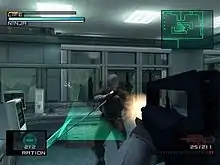Metal Gear Solid: The Twin Snakes
Metal Gear Solid: The Twin Snakes[lower-alpha 1] is an action-adventure stealth video game co-developed by Silicon Knights and Konami Computer Entertainment Japan for the GameCube video game console in March 2004.[1] The game is a remake of Metal Gear Solid, originally developed by Konami Computer Entertainment Japan for the PlayStation in 1998.
| Metal Gear Solid: The Twin Snakes | |
|---|---|
 | |
| Developer(s) | Silicon Knights Konami Computer Entertainment Japan |
| Publisher(s) | Konami |
| Director(s) | Carey Murray |
| Producer(s) | Hideo Kojima Yoshikazu Matsuhana Denis Dyack |
| Designer(s) | Hideo Kojima |
| Artist(s) | Yoji Shinkawa |
| Writer(s) | Hideo Kojima Tomokazu Fukushima |
| Composer(s) | Norihiko Hibino Steve Henifin Toshiyuki Kakuta Shuichi Kobori Waichiro Ozaki |
| Series | Metal Gear |
| Platform(s) | GameCube |
| Release | |
| Genre(s) | Action-adventure, stealth |
| Mode(s) | Single-player |
The Twin Snakes features graphical improvements over the original, new cutscenes written and directed by Ryuhei Kitamura, and gameplay functions originally introduced in the sequel Metal Gear Solid 2: Sons of Liberty. The game includes a revised translation with re-recorded voice acting using almost all of the original English voice cast.[2] The game was met with positive reception.
Gameplay

The gameplay of The Twin Snakes was altered to resemble that of Metal Gear Solid 2: Sons of Liberty. While all of the original areas and enemies were kept, new ways for the player to combat them were introduced, such as the ability to shoot from a first-person view.[2] Enemy AI was improved, giving enemy soldiers the ability to communicate with each other and detect the player more intelligently with senses of sight and sound enhanced.[3]
Development
The Twin Snakes was first announced in 2003 by Nintendo of America, confirming that Silicon Knights would be developing under the guidance of Metal Gear creator Hideo Kojima and Mario creator Shigeru Miyamoto.[4]
Although The Twin Snakes was largely developed at Silicon Knights, Ryuhei Kitamura directed many of the game's cinematics while Silicon Knights implemented them into the game[5] to look identical to those in the original Metal Gear Solid, but upon inspection Hideo Kojima asked Kitamura to redo them in his well-known action style.[6] The game's composition duties were split: some of the in-game music was handled by Steve Henifin and Silicon Knights' music staff, while the rest of the music (in-game, menus and cut scenes) was handled by Konami's music staff, including Metal Gear Solid 2 co-composer Norihiko Hibino.
Voice acting
The voice acting was re-recorded with the original cast from Metal Gear Solid, except for the role of the Cyborg Ninja. David Hayter, the English voice of Solid Snake, persuaded Konami Computer Entertainment Japan to have the original voice cast reprise their roles.[7] The main reason for the re-recording, according to an interview with Hayter, was because the increased audio quality allowed by the GameCube picked up outside noise from the original recordings that were inaudible in the PlayStation version. In the original game, Gray Fox and Donald Anderson were both voiced by Greg Eagles. However, in The Twin Snakes, Greg Eagles voices only Anderson, whereas Gray Fox was voiced by Rob Paulsen. The revised voice acting is used in Metal Gear Solid 4 during Snake's reminiscence as the English-language voice-recording used in the original game was not recorded in a sound-proof studio.[7][8][9] Mei Ling, Nastasha Romanenko, and Naomi Hunter speak with American accents in The Twin Snakes, whereas in the original Metal Gear Solid, they spoke with Chinese, Ukrainian, and British accents, respectively.
| Metal Gear fictional chronology |
|---|
|
| Voice actor | Character |
|---|---|
| David Hayter | Solid Snake |
| Cam Clarke | Liquid Snake |
| Debi Mae West | Meryl Silverburgh |
| Jennifer Hale | Naomi Hunter |
| Christopher Randolph | Hal "Otacon" Emmerich |
| Paul Eiding | Roy Campbell |
| Kim Mai Guest | Mei Ling |
| Rob Paulsen | Gray Fox |
| Renee Raudman | Nastasha Romanenko |
| Patric Zimmerman | Revolver Ocelot |
| Peter Lurie | Vulcan Raven |
| Doug Stone | Psycho Mantis |
| Tasia Valenza | Sniper Wolf Computer Voice |
| Greg Eagles | Donald Anderson |
| Allan Lurie | Kenneth Baker |
| William H. Bassett | Jim Houseman |
| Dean Scofield | Johnny Sasaki |
Release
The Twin Snakes was released on March 9, 2004 in North America. It was originally to be released in November 2003, but was pushed back, along with the other versions.[10] The European date was pushed back several weeks.[11]
In Japan The Twin Snakes was released on March 11 alongside an exclusive Premium Package. The box includes the game itself; a platinum-colored GameCube adorned with the FOXHOUND logo; a 44-page book titled Memorandum containing production notes, sketches and photos; and a GameCube disc called the "Special Disc" containing an emulated version of the Family Computer version of the original Metal Gear.[12]
Reception
Much like the original Metal Gear Solid was met with acclaim from critics, The Twin Snakes received an 85.58% and 85/100 from GameRankings and Metacritic, respectively.[15][16] IGN gave The Twin Snakes 8.5 out of 10, praising its superior graphics and likening the presentation to epic movies.[17] GameSpot gave it an 8.2 out of 10 or "Great" on their scale,[3] Eurogamer rated The Twin Snakes as 8 out of 10 and Gaming Age gave it a "A-" rating. Game Informer gave The Twin Snakes a 9.25 out of 10, citing its improved gameplay and graphics, and also its faithful retelling of the original Metal Gear Solid story.[18] The publication later placed The Twin Snakes at #11 on their list of "Top 25 GameCube Games" in 2009.[19]
Despite receiving generally favorable reviews, The Twin Snakes has also drawn criticism. According to GamePro, the game has a "flagging framerate and bouts of slowdown that occur when too much activity crowds the screen."[20] The use of new gameplay elements from Sons of Liberty was seen as unnecessary, as GamePro thought that the level design was virtually unchanged from Metal Gear Solid,[20] which "spoils the challenge... and completely ruins one boss battle (Revolver Ocelot)."[21]
References
Notes
- Known in Japan as Metaru Gia Soriddo Za Tsuin Sunēkusu (メタルギアソリッド ザ・ツインスネークス, "Metal Gear Solid: The Twin Snakes")
Footnotes
- "Metal Gear Solid The Twin Snakes Tech Info/Credits". GameSpot. Archived from the original on February 18, 2006. Retrieved October 25, 2006.
- "MGS: Old Versus New". IGN. Archived from the original on March 6, 2016. Retrieved October 28, 2006.
- Tim Tracy. "Twin Snakes review". GameSpot. Archived from the original on September 30, 2007. Retrieved October 26, 2006.
- "Metal Gear Solid Official". IGN. Retrieved October 28, 2006.
- https://www.youtube.com/watch?v=vATC82iHx1c#t=4m30s
- "Hideo Kojima Q&A". GameSpot. Retrieved April 14, 2016.
- "David Hayter interview on Evil Avatar Radio".
- "Kojima Productions Ryan Payton interviews Debi Mae West". Archived from the original on 2016-03-03.
- "Kojima Productions Ryan Payton interviews Kris Zimmerman". Archived from the original on 2016-03-03.
- "Snake Gets a Date". IGN. Retrieved October 28, 2006.
- "Twin Snakes Late in Europe". IGN. Retrieved October 28, 2006.
- Hirohiko Niizumi. "Twin Snakes to come bundled". GameSpot. Retrieved October 28, 2006.
- GameSpot Review
- IGN Review
- "Metal Gear Solid: The Twin Snakes for GameCube". GameRankings. Retrieved October 28, 2006.
- "Metal Gear Solid: The Twin Snakes for GameCube Reviews". Metacritic. Retrieved October 26, 2006.
- Matt Casamassina. "Twin Snakes review". IGN. Retrieved October 28, 2006.
- Reiner. "Twin Snakes review". Game Informer. Archived from the original on June 6, 2009. Retrieved October 28, 2006.
- Reeves, Ben (22 September 2009). "GameCube Top 25". Game Informer. Retrieved April 8, 2016.
- Mike, Major (April 2004). "ProReview: Metal Gear Solid: The Twin Snakes". GamePro (187): 64.
- Macdonald, Mark (April 2004). "Metal Gear Solid: The Twin Snakes". Electronic Gaming Monthly (177): 126–128.
External links
| Wikiquote has quotations related to: Metal Gear Solid: The Twin Snakes |